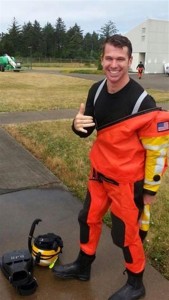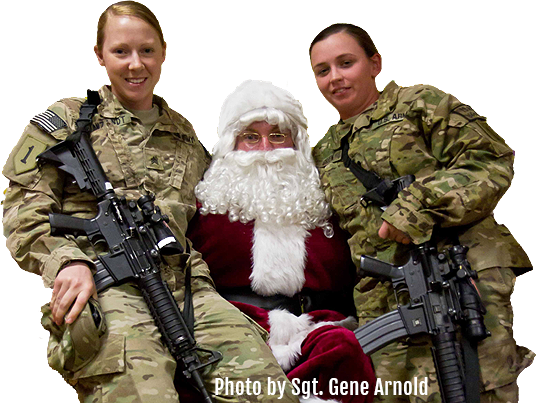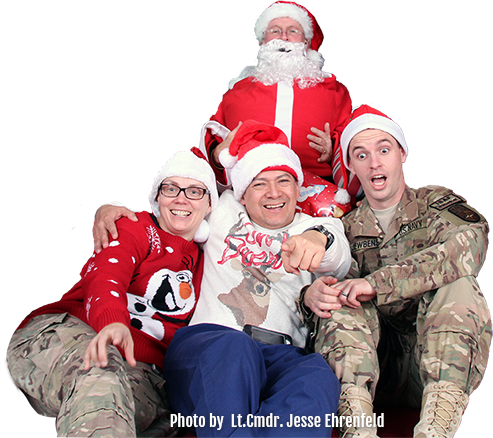COAST GUARD AIR STATION North Bend, Oregon., Aug. 4, 2015 – An Olympic-length triathlon swim is just under a mile -- 0.9 miles to be exact. A Coast Guard rescue swimmer completed a triathlon swim of a different nature and saved four lives July 21, 2015.
Coast Guard Petty Officer 2nd Class Darren Harrity, an aviation survival technician assigned here, swam a total of 0.99 miles, half of which was done while body towing grown adults to shore after their 52-foot commercial fishing vessel ran aground near Cape Blanco, Oregon. Harrity returned to the 57-degree water four times and pulled each fisherman about 250 yards to shore, where they were met by emergency medical services. Each of the fishermen were the same size or larger than the 6-foot, 175-pound Harrity. Coast Guard Petty Officer 2nd Class Darren Harrity, an aviation survival technician assigned to Coast Guard Air Station North Bend, rescued four people from a fishing vessel that ran aground in the early morning hours of July 21, 2015. U.S. Coast Guard photo “The rescue was definitely one of the most challenging I have ever done, and it was the first one for me at night,” said Harrity, a 27-year-old native of Jupiter, Florida. “My fellow aircrew members shined a spotlight down in my general direction, and the mast light from the fishing vessel lit up the life raft quite well. I also used the headlights from the emergency medical vehicles on shore to guide me into the beach.” After being dispatched by watchstanders at Coast Guard Sector North Bend, Harrity and his fellow aircrew members arrived on scene at 2:49 a.m. The call for help was received at 1:40 a.m., so when Harrity arrived at the side of their life raft, the fisherman had been floating alone in the Pacific Ocean for more than an hour.
Coast Guard Petty Officer 2nd Class Darren Harrity, an aviation survival technician assigned to Coast Guard Air Station North Bend, rescued four people from a fishing vessel that ran aground in the early morning hours of July 21, 2015. U.S. Coast Guard photo “The rescue was definitely one of the most challenging I have ever done, and it was the first one for me at night,” said Harrity, a 27-year-old native of Jupiter, Florida. “My fellow aircrew members shined a spotlight down in my general direction, and the mast light from the fishing vessel lit up the life raft quite well. I also used the headlights from the emergency medical vehicles on shore to guide me into the beach.” After being dispatched by watchstanders at Coast Guard Sector North Bend, Harrity and his fellow aircrew members arrived on scene at 2:49 a.m. The call for help was received at 1:40 a.m., so when Harrity arrived at the side of their life raft, the fisherman had been floating alone in the Pacific Ocean for more than an hour.
Terrain Made Rescue a Challenge Harrity knew before leaving the helicopter that he was in for a long and taxing morning. “The flight down from North Bend was the most stressful event of the whole rescue,” said Harrity. “We flew into thick fog and strong wind, but because of the skill of the pilots I knew it would be okay. The knowledge of what was on the other end of our flight pushed us to keep going.” The air crew discussed the rescue plan and the weather conditions on the way from North Bend to Cape Blanco. “We knew going in that the wind and the severe downdrafts coming off the cliffs of Cape Blanco were going to be beyond the helicopter’s limitations and it would be too dangerous to hover and conduct hoisting operations,” said Harrity.
In the water, despite 5-foot seas and 30-mph winds, Harrity was in his element. He began rescuing each fisherman one-by-one until all four were safely on shore. “We, rescue swimmers, train in the gym and the pool on a weekly basis, so I felt physically ready and I mentally prepared myself to succeed en route,” said Harrity. “I also surf on my off time, so the ocean and the water really is my element, and I really felt comfortable conducting this rescue.” Training Saved Lives Being in your element and feeling comfortable is one thing, but always being able to rely on your training is essential for all Coast Guardsmen, especially rescue swimmers. “I also used my training received from the Advanced Rescue Swimmer School to use the rip currents coming off the shore to my advantage and return to the life raft faster and to conserve energy.” Harrity said that the biggest issues he had during the rescue was overcoming the fumes from the oily substance surrounding the life raft and the cramps that came upon him mid-rescue.
He said the entire evolution went as smoothly as anything like that could. “This was a tremendous team effort that demonstrates the strength and importance of the Coast Guard’s rescue swimmer program,” said Cmdr. Robert Workman, chief of response and aviation operations officer at Sector North Bend. “Petty Officer Darren Harrity did a fantastic job pulling four fishermen, each in full survival suits, to shore through waves, surf and darkness.” Rescues are always a team effort whether it is interagency or combining forces with local first responders. This case was no different, as the lights from the EMS vehicles on shore helped the rescue get completed successfully, as well as helping Harrity get back to Air Station North Bend safely. “It was unsafe for the helicopter to come into the beach and pick me up, so the remaining members of my crew flew back to North Bend and I hitched a ride back aboard the Cape Blanco Fire and Rescue engine,” said Harrity. “It was nice because I got to spend some extra time with the fishermen I just rescued.”
Written August 4, 2015 By: Coast Guard Petty Officer 1st Class Levi Read Public Affairs Detachment Astoria
Republished and redistributed by SOT by permission of DOD






